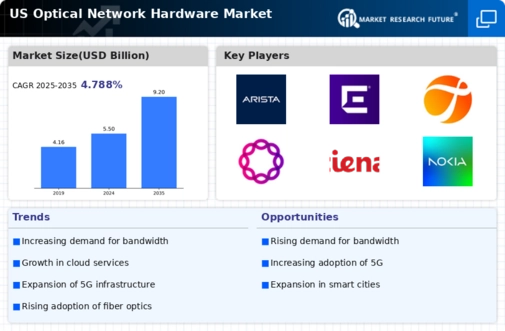The US Optical Network Hardware Market is characterized by a dynamic competitive landscape driven by rapid technological advancements and the increasing demand for high-speed connectivity. This market encompasses various segments, including optical switches, routers, and transceivers, which are essential for data transmission and communication over fiber optic infrastructure. The competition is fueled by the presence of both established players and emerging startups, all striving to capture market share by innovating and enhancing the efficiency and performance of their products.
As demand for bandwidth continues to surge due to the proliferation of data-heavy applications, companies in this space are focusing on expanding their capabilities and enhancing their offerings to maintain a competitive edge.FiberHome Technologies has established a noteworthy presence in the US Optical Network Hardware Market, where it leverages its expertise in optical communication technologies to deliver robust networking solutions. The company's strengths lie in its comprehensive portfolio of products that cater to various aspects of optical networks, enabling it to meet diverse customer requirements.
Additionally, FiberHome Technologies has invested in R&D to innovate advanced optical components and systems, ensuring that it remains relevant in a fast-evolving market. The company's commitment to quality, reliability, and customer satisfaction has helped it forge strong relationships with clients in various sectors, thereby reinforcing its standing in the competitive landscape of the US market.Arista Networks operates prominently within the US Optical Network Hardware Market, known for its cutting-edge cloud networking solutions and high-performance networking products.
The company has developed a range of key products, including high-speed data center switches and software-defined networking solutions, which cater specifically to the needs of large-scale data centers and enterprises. Arista Networks has been successful in establishing a strong market presence through strategic mergers and acquisitions, allowing it to expand its technology portfolio and enhance its capabilities. Its focus on innovation, customer-centric approach, and robust track record in the deployment of advanced networking systems position Arista Networks as a formidable player in the US market.
The company’s strengths lie in its ability to deliver scalable and adaptable solutions that align with the evolving needs of its clients, making it a valuable contender in the highly competitive landscape of optical networking hardware.









